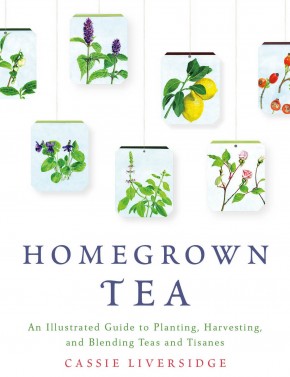
Homegrown Tea explains how to grow a large variety of plants in your own garden, on a balcony or even on a window sill could become your tea cupboard. It shows you how to grow your tea from seeds, cuttings, or small plants, as well as which parts of the plant are used to make tea.
Liversidge lays out when and how to harvest your plants, as well as information on how to prepare the plant, including how to dry tea leaves to make tea you can store to last you throughout the year. As a guide to using tea to make you feel better, there are nutritional and medicinal benefits. Finally, there is an illustrated guide to show how to make up fresh and dried teabags and how to serve a delicious homegrown tea. It is sustainable way to look at a beverage, which is steeped in history and tradition.
Sample drinks include well-known plants such as rose hips, mint, sage, hibiscus, and lavender, as well as more obscure ones like chicory, angelica, apple geranium, and lemon verbena.
I’ll never again complain about paying a pretty penny for high-quality tea, now that I understand what it takes to tend one measly Camellia sinensis. Not less than 11 hours of sunlight, please! No direct heat over a prolonged time! Must have misty mornings and evenings! And I thought roses were divas. The frustrating thing about growing camellias of any sort in Northeastern gardens is that one of these days you’ll take a trip to New Orleans and despair when you see them running rampant in abandoned lots. The same happens when you visit Los Angeles and spot the jade plant you’re coddling back in your sunroom, here planted in hedges and hacked back with chain saws.
Liversidge moves off Chinese camellias quickly and offers dozens of options for tisanes, or herbal infusions. This is where the fun begins. What to do with all those scarlet rose hips as autumn’s chill descends? Harvest them; when blended with mountain pepper, rose hip tea will be an excellent source of vitamin C through the long winter. Lemon verbena is “wonderful if you are detoxing” — though there’s altogether too much worry in the air about detoxing, and I hate to encourage that sort of thinking. New Jersey can throw its own tea party with local tea, Ceanothus americanus, a small deciduous shrub. Politicians will be glad to learn that it soothes sore throats.
Drink up. After you’re done with the sowing and watering, the feeding and the harvesting, the drying and the chopping, you’ll be thankful that on the seventh day, while we were resting, God invented the supermarket.
There are plenty of reasons to turn your back on the world’s travails, join Candide and lock the gate behind you. Voltaire himself was a gardener; it was an important pastime, he said, as it was an extraordinarily effective way to keep busy. Don’t we know it! We may not live in the best of all possible worlds, but every gardener cultivates hope. And those are seeds worth planting.
“Three proposals, three deals, each better than the last. Professional and ambitious, Creative Authors is a great agency to have on your side.”
Tristan Donovan, Creative Authors Client